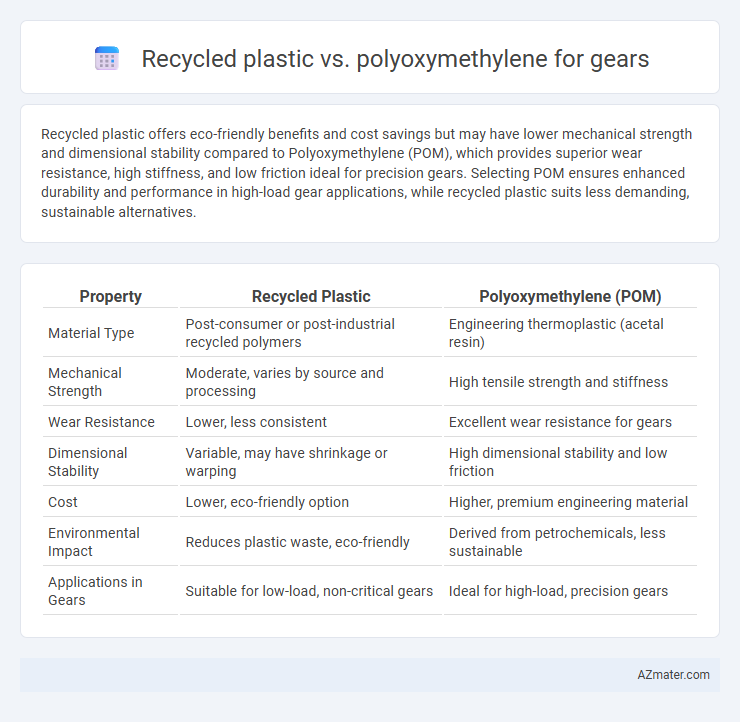Recycled plastic offers eco-friendly benefits and cost savings but may have lower mechanical strength and dimensional stability compared to Polyoxymethylene (POM), which provides superior wear resistance, high stiffness, and low friction ideal for precision gears. Selecting POM ensures enhanced durability and performance in high-load gear applications, while recycled plastic suits less demanding, sustainable alternatives.
Table of Comparison
| Property | Recycled Plastic | Polyoxymethylene (POM) |
|---|---|---|
| Material Type | Post-consumer or post-industrial recycled polymers | Engineering thermoplastic (acetal resin) |
| Mechanical Strength | Moderate, varies by source and processing | High tensile strength and stiffness |
| Wear Resistance | Lower, less consistent | Excellent wear resistance for gears |
| Dimensional Stability | Variable, may have shrinkage or warping | High dimensional stability and low friction |
| Cost | Lower, eco-friendly option | Higher, premium engineering material |
| Environmental Impact | Reduces plastic waste, eco-friendly | Derived from petrochemicals, less sustainable |
| Applications in Gears | Suitable for low-load, non-critical gears | Ideal for high-load, precision gears |
Introduction to Gear Material Selection
Selecting gear materials requires balancing durability, wear resistance, and cost-efficiency, where recycled plastic offers environmental benefits and lightweight properties but may lack the mechanical strength of polyoxymethylene (POM). POM, known for its high stiffness, low friction, and excellent dimensional stability, excels in precision gear applications requiring prolonged performance under load. Choosing between recycled plastic and POM involves evaluating application-specific demands, including load capacity, operational environment, and sustainability goals.
Overview of Recycled Plastic for Gears
Recycled plastic for gears offers an eco-friendly alternative by reusing post-consumer or industrial plastic waste, reducing environmental impact and raw material costs. These plastics, often composed of polyethylene, polypropylene, or PET, provide adequate strength, durability, and wear resistance suitable for low- to medium-load gear applications. While recycled plastic gears may exhibit lower mechanical performance compared to virgin Polyoxymethylene (POM), their sustainability benefits and cost-effectiveness make them attractive for less demanding industrial and consumer product gear solutions.
Properties of Polyoxymethylene (POM) in Gear Applications
Polyoxymethylene (POM) exhibits exceptional mechanical strength, low friction, and high wear resistance, making it ideal for precision gear applications requiring durability and smooth operation. Its excellent dimensional stability and resistance to moisture and chemicals ensure consistent performance under varying environmental conditions, unlike many recycled plastics that may degrade over time. POM's low coefficient of thermal expansion and inherent self-lubricating properties contribute to reduced maintenance and extended gear lifespan in industrial and automotive sectors.
Mechanical Performance Comparison: Strength and Durability
Recycled plastic gears generally offer moderate mechanical strength but exhibit lower durability compared to Polyoxymethylene (POM) gears due to their variable material consistency and potential contaminants. Polyoxymethylene provides high tensile strength, excellent wear resistance, and superior fatigue endurance, making it ideal for high-load, precision gear applications. The enhanced crystallinity and dimensional stability of POM contribute to consistent performance under repeated mechanical stress, outperforming most recycled plastics in gear longevity.
Wear Resistance and Friction Analysis
Recycled plastic gears exhibit moderate wear resistance but generally have higher friction coefficients compared to polyoxymethylene (POM), which is renowned for its superior wear resistance and low friction properties due to its high crystallinity and molecular structure. POM gears demonstrate excellent dimensional stability and reduced abrasive wear in dynamic applications, making them ideal for high-load and precision gear systems. In contrast, recycled plastic materials may require surface treatments or additives to enhance wear performance and reduce friction, limiting their suitability for high-performance gear applications.
Environmental Impact: Sustainability and Carbon Footprint
Recycled plastic gears significantly reduce environmental impact by lowering waste and diminishing the demand for virgin materials, contributing to circular economy principles. Polyoxymethylene (POM), while offering excellent mechanical properties and durability, is typically derived from petrochemicals, resulting in higher carbon footprints compared to recycled plastics. Sustainable gear manufacturing favors recycled plastics for minimizing carbon emissions and conserving resources throughout the product lifecycle.
Cost Effectiveness and Market Availability
Recycled plastic offers significant cost advantages compared to polyoxymethylene (POM), typically reducing material expenses by up to 40%, making it attractive for budget-sensitive gear manufacturing. Market availability of recycled plastics is robust due to widespread recycling programs and growing sustainable material initiatives, ensuring a consistent supply chain. Conversely, polyoxymethylene, while more expensive, provides superior mechanical properties and precision, but its higher cost and limited large-scale supply restrict its usage primarily to high-performance or specialized gear applications.
Manufacturing and Processing Considerations
Recycled plastic offers cost-effective manufacturing with lower energy consumption and reduced environmental impact compared to virgin materials, but it may present challenges in consistency and mechanical properties control for gear production. Polyoxymethylene (POM), known for its high stiffness, low friction, and excellent dimensional stability, allows precision machining and injection molding with predictable performance, making it suitable for high-load and high-speed gear applications. Processing POM requires controlled drying and temperature conditions to prevent degradation, while recycled plastics often demand additional quality checks and modification to maintain reliability in gear manufacturing.
Application Suitability: Industrial and Consumer Sectors
Recycled plastic offers cost-effective and environmentally friendly options for low-load, non-precision gears in consumer products such as toys and household appliances. Polyoxymethylene (POM) excels in industrial applications requiring high strength, wear resistance, and dimensional stability, making it ideal for precision gears in automotive, robotics, and machinery. The choice between recycled plastic and POM depends on the performance demands, with POM preferred for durability and recycled plastic favored for sustainability and cost-efficiency in less demanding uses.
Conclusion: Choosing the Right Material for Gear Production
Recycled plastic offers cost-effective and environmentally sustainable benefits ideal for low-stress gear applications, while polyoxymethylene (POM) provides superior mechanical strength, dimensional stability, and wear resistance crucial for high-performance gear systems. Selecting the right material depends on the specific operational demands, with POM preferred for precision and durability, and recycled plastic suitable for budget-conscious and eco-friendly projects. Evaluating factors such as load, speed, environmental impact, and lifecycle cost ensures optimal gear production outcomes.

Infographic: Recycled plastic vs Polyoxymethylene for Gear
 azmater.com
azmater.com